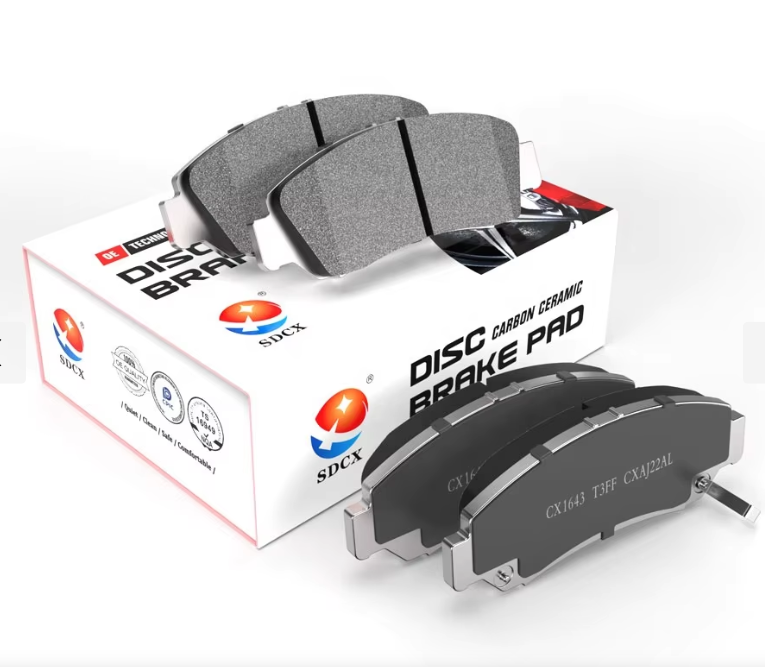Types of Brake Pads and Their Key Features
Semi-Metallic Brake Pads: Durability for Performance Driving
Semi-metallic brake pads are widely recognized in the industry for their durability and outstanding performance characteristics, particularly in high-temperature conditions. Composed of 30% to 65% metal content, including materials such as steel wool, copper, and wire, these pads are bound together with an organic resin. This unique composition makes them remarkably resistant to heat, allowing for sustained performance during high-intensity driving, such as in racing or performance vehicles. Notably, semi-metallic pads demonstrate a longer lifespan under extreme conditions compared to other types. According to industry research, they often outlast their counterparts due to their robust metal composition, making them an ideal choice for those who prioritize durability and performance.
Ceramic Brake Pads: Quiet Excellence for Daily Use
Ceramic brake pads are engineered for daily driving, offering a quiet and efficient braking experience. Unlike other types, ceramic pads consist of dense ceramic material interwoven with fine copper fibers. This design not only ensures effective braking but also minimizes noise and dust production, making them a popular choice for urban drivers who value a smooth and clean braking system. Experts highlight their superior thermal management capabilities, which help maintain consistent performance in various driving conditions. Reports and surveys indicate high levels of user satisfaction, owing to their reliability and low maintenance requirements. In summary, ceramic pads provide an excellent balance of performance and comfort for everyday use without compromising on quality.
Low-Metallic NAO Brake Pads: Balanced Heat Management
Low-Metallic NAO brake pads offer a balanced performance, blending organic materials with a metal content of 10% to 30%, usually copper or steel. This combination facilitates efficient heat dissipation, which is crucial for maintaining braking performance, especially during aggressive or moderate driving. Moreover, these pads are environmentally friendly compared to their semi-metallic counterparts, emitting lower levels of dust and metals. Industry experts and cost analyses affirm the cost-effectiveness of low-metallic NAO pads in relation to other brake types, as they provide reliable stopping power while remaining budget-conscious. Their ability to perform under varying driving conditions makes them a versatile option for drivers seeking both performance and environmental responsibility.
Non-Asbestos Organic Brake Pads: Budget-Friendly City Driving
Non-asbestos organic brake pads are composed mainly of organic materials such as rubber, glass, and Kevlar, offering an affordable and quiet option for city driving. These pads are designed to be softer, which reduces the noise and wear on brake discs. They are cost-effective, catering to drivers who prioritize comfort and budget in urban settings. However, they may not perform as well under high-stress or heavy braking conditions compared to semi-metallic or ceramic options. Despite this, feedback from city drivers often highlights their preference for these pads due to their quieter operation. They are particularly favored in urban environments where frequent braking is necessary, making them a practical choice for everyday commuters.
Factors to Consider When Choosing Brake Pads
Driving Style: Aggressive vs. Conservative Habits
Understanding your driving style is crucial when selecting the ideal brake pads. Aggressive driving, characterized by frequent, hard braking and high speeds, demands brake pads with enhanced performance features, such as better heat dissipation and greater stopping power. For instance, semi-metallic brake pads are often favored by aggressive drivers because of their durability and efficiency in high-temperature conditions. Conversely, conservative driving, which emphasizes smoother braking and fuel efficiency, might prioritize brake pads that offer longevity and quiet operation. Ceramic brake pads, known for their low noise and dust production, typically fit this style well. Studies have shown that aggressive driving habits correlate with faster brake pad wear, so selecting brake pads that align with personal driving habits ensures both safety and optimal performance.
Vehicle Weight and Towing Requirements
The weight of your vehicle plays a critical role in determining the appropriate brake pads, especially for heavier vehicles and those used for towing. Heavy-duty trucks and SUVs require brake pads that offer exceptional stopping power and durability to manage the additional mass and momentum. High-performance brake pads, like semi-metallic ones, are often recommended for vehicles with significant towing needs as they provide superior heat resistance and braking efficiency. It's noteworthy that inadequate brake pads can compromise safety and braking efficiency, particularly under heavy loads. Research indicates that using brake pads not suited for a vehicle's weight can increase stopping distances and decrease overall safety margins, underscoring the importance of selecting the right brake pads for your specific vehicle and towing requirements.
Climate: Heat Resistance vs. Cold-Weather Performance
Climate conditions significantly impact brake pad performance, necessitating careful consideration of materials matched to temperature extremes. In hot climates, brake pads with high heat resistance, such as semi-metallic or ceramic variants, are crucial to prevent brake fade and maintain stopping efficiency. Conversely, in colder environments, brake pads with good cold-weather performance are essential to ensure reliable function when temperatures drop. Seasonal changes also influence brake pad selection, with some pads performing better in wet conditions to avoid skidding or loss of traction. Data suggests that brake fade can be a common issue in high heat, while some brake pads improve performance in colder climates, offering a stable friction coefficient. When selecting brake pads, it's prudent to consider your local climate and driving conditions to ensure your vehicle performs safely and efficiently throughout the year.
Best Brake Pads for Different Vehicle Types
Compact Cars: Lightweight Organic or Ceramic Options
For compact cars, I recommend using lightweight brake pads, specifically organic or ceramic variants. Both types are excellent choices but serve different needs; organic pads are softer and provide more noise reduction, while ceramic pads offer superior durability and less brake dust. For city driving, these pads excel because they balance between quiet operation and strong performance, especially during frequent stops. Organic pads tend to be less expensive, making them a budget-friendly option, while ceramic pads perform better in terms of longevity. The crucial factor is finding a balance that aligns with your driving style and budget.
SUVs and Crossovers: Semi-Metallic or Heavy-Duty Pads
When it comes to SUVs and crossovers, the use of semi-metallic or heavy-duty brake pads is highly recommended. These pads are designed to handle the added weight and stress typical of these larger vehicles, offering excellent heat dissipation and durability. Given their robust design, these pads can deliver consistent performance under various driving conditions and loads. Brands like Wagner or Bosch are renowned in the SUV market for their reliable performance, showcasing high safety ratings and extensive performance testing outcomes. Selecting these pads ensures that SUVs maintain effective braking and optimal safety even in demanding situations.
Trucks: Severe-Duty Brake Pads for Heavy Loads
Trucks, particularly those that carry heavy loads, necessitate severe-duty brake pads that cater to high-torque applications. These pads are engineered to withstand intense heat, provide substantial stopping power, and endure prolonged use loaded with cargo. Case studies and statistics affirm the vital role these pads play in maintaining performance during regular truck usages, such as towing or off-road driving. Brands with a strong reputation and appropriate certifications dominate this segment, emphasizing the importance of trusted recommendations when purchasing severe-duty brake pads for trucks.
Brake Pad Recommendations for Every Budget
Budget-Friendly: Organic or Entry-Level Ceramic
For those looking to keep costs down, organic or entry-level ceramic brake pads offer a budget-friendly option. Organic brake pads are made from materials like rubber, glass, or fibers, making them gentle on brake rotors and quieter during use. These are perfect for drivers with a light driving style and not much demand on the braking system. On the other hand, entry-level ceramic pads are slightly more costly but offer better performance and longevity. The trade-off with budget-friendly pads is that they might not last as long or perform as well under stress compared to more expensive options. Here's a quick look at pricing: Organic pads often start as low as $25 per set, while ceramics can range from $30 to $50. Brands known for affordable brake pads include Wagner and Raybestos, both of which have positive user reviews regarding value and satisfaction.
Mid-Range: Semi-Metallic or Hybrid Formulations
When considering mid-range brake pads, semi-metallic or hybrid formulations stand out for their balance between cost and performance. Semi-metallic pads, composed of metals and fillers, provide excellent stopping power and durability, ideal for diverse driving conditions. Hybrid pads, combining aspects of ceramic and metallic materials, further optimize performance and versatility. These pads are priced between $50 to $80 per set, making them accessible without sacrificing quality. Consumer trends and expert reviews frequently highlight their value for money, with brands like Akebono and EBC Brakes receiving high praise. Models in this category have been shown to perform well in both performance tests and everyday use, making them a solid choice for those not looking to overspend while still seeking reliability and durability.
Premium: High-Performance Ceramic or Carbon-Metallic
For those seeking top-tier performance, premium brake pads like high-performance ceramic and carbon-metallic variants deliver exceptional benefits. Engineered for high-stress environments, these pads are designed to tackle the toughest driving conditions with superior heat handling and stopping power. Ceramic pads excel in providing a quiet, dust-free operation; meanwhile, carbon-metallic pads offer even greater performance under severe conditions. Prices for these premium options can reach upwards of $100, but the investment is justified by impressive ratings from automotive experts. Many drivers have testified to the noticeable improvement in vehicle performance these pads provide, finding them especially beneficial in sports or performance vehicles. Overall, choosing premium brake pads rewards the driver with unmatched engineering and technological advancements, ideal for those who prioritize peak vehicle performance.
FAQ
What are the main types of brake pads?
The main types of brake pads include semi-metallic, ceramic, low-metallic NAO, and non-asbestos organic. Each type has unique features that cater to different driving needs.
Which brake pads are best for performance driving?
Semi-metallic brake pads are a top choice for performance driving due to their durability and heat resistance, making them ideal for high-intensity conditions.
Are ceramic brake pads suitable for city driving?
Yes, ceramic brake pads are an excellent choice for city driving. They offer quiet operation, low dust production, and consistent performance, making them perfect for urban environments.
What should I consider when choosing brake pads for heavy vehicles?
For heavier vehicles, consider brake pads with superior stopping power and heat resistance, such as semi-metallic or heavy-duty variants, to ensure safety and efficiency.
How do climate conditions affect brake pad performance?
Brake pad performance varies with climate conditions. High heat resistance is crucial for hot climates, while pads with good cold-weather performance are essential for colder environments.

